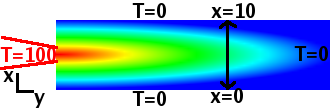
A thin infinitely long plate is heated in the middle of one of the short edges. What is the temperature profile $T(x,y)$?
| As there is no heat source within the plate, Laplace's equation is applicable: | $\nabla^2T=0$, |
| which is short for: | $\frac{\partial^2T}{\partial x^2}+\frac{\partial^2T}{\partial y^2}=0$. |
The first step of solving the PDE is separating it into two separate ODEs with respect to each of the two independent variables. To do this, we assume that a solution can be obtained by multiplying two functions of each one of the two variables only: $T(x,y)=X(x)Y(y)$. Capital letters indicate functions (dependent variables), lower-case letters represent independent variables.
| Substitute product approach into PDE: | $\frac{\partial^2XY}{\partial x^2}+\frac{\partial^2XY}{\partial y^2}=0$. |
| $Y(y)$ doesn't depend on $x$ and is moved in front of the differential: | $Y\frac{{\rm d}^2X}{{\rm d}x^2}+X\frac{{\rm d}^2Y}{{\rm d}y^2}=0$, |
| which reduces the differentials to ordinary differentials. | |
| Divide by $XY$: | $\frac{1}{X}\frac{{\rm d}^2X}{{\rm d}x^2}+\frac{1}{Y}\frac{{\rm d}^2Y}{{\rm d}y^2}=0$. |
Now the point is that the left term depends on $x$ only, while the right term depends on $y$ only. However, they must add up to zero for whichever combination of $x$ and $y$ values. This is only possible if both of them are in fact constant and equal (but with opposite sign). It turns out to be convenient to choose $-k^2$ as that constant because that will make the eventual solution look simpler.
| Following the above argument, | $\frac{1}{X}\frac{{\rm d}^2X}{{\rm d}x^2}=-\frac{1}{Y}\frac{{\rm d}^2Y}{{\rm d}y^2}=-k^2$. |
| Therefore the $x$-ODE is: | $\frac{1}{X}\frac{{\rm d}^2X}{{\rm d}x^2}=-k^2$, |
| and the $y$-ODE is: | $\frac{1}{Y}\frac{{\rm d}^2Y}{{\rm d}y^2}=k^2$. |
Both of these are linear ODE with constant coefficients and can besolved accordingly.
In order to continue solving Laplace's equation, we first need to find out how to solve linear ODE of any order with constant coefficients.